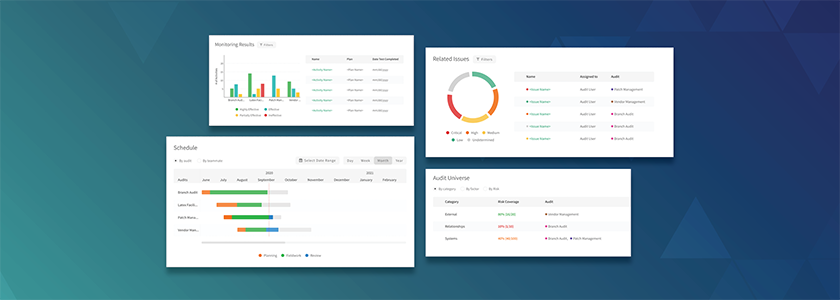Looking Around the Corner:
Why ESG Has Never
Been More Important
By Steven Minsky | June 24, 2021

Introduction: Why is ESG important?
The topic of environmental, social and governance (ESG) criteria is especially prominent right now. But why is ESG important?
It’s all about the See-Through Economy. By taking a look at trends and patterns over the course of recent history, it’s clear that ESG is a growing concern for consumers, investors and regulators everywhere. The See-Through Economy has driven the value of global assets applying environmental, social and governance data to drive investment decisions to almost double over four years, and more than triple over eight years, to reach $40.5 trillion in 2020. An enforcement action wave is underway by the SEC and other regulatory bodies for an ERM-based approach that provides evidence to support a company’s ESG-related disclosures. Since a company’s ESG disclosure drives investor demand and investor demand drives stock price, ESG disclosures will be receiving similar quality scrutiny to SOX attestations. Misstatements within these disclosures will receive the same penalty as financial fraud, as well as class-action lawsuits.
This blog post is Part II in my ongoing blog series that dives into my predictions for 2021-2024. Keep reading to learn why ESG has become more important than ever, why companies should care about it, the challenges businesses are facing when it comes to ESG (and how to address those challenges), and ultimately why taking an Enterprise Risk Management approach to implementing and managing your ESG strategy is critical for success.
What History has Taught us About ESG
ESG awareness in today’s society has never been higher. But this awareness is something that has been gaining momentum for over a decade. Nowadays more companies want to know what ESG is and how they can apply it to their company to build an ESG Bowtie.
After the 2008 recession, people lost trust in large corporations. As a result, federal regulations like the Dodd Frank Act and Sarbanes-Oxley brought forth regulatory scrutiny in an effort to help consumers feel more protected. These regulations raised the standard for good governance: a key vector of ESG.
Much like the economic crash that took place 14 years ago, the COVID-19 pandemic shot up a flare that illuminated new risks and opportunities on the ground. People have new and heightened concerns now related to everything from health and safety, to social justice, the unstable economy, and much more. As a result, consumers are seeking trustworthy companies that align with their values.
This all goes back to the power of the See-Through Economy: the state of our current environment where the smartphone has given everyone 24/7 access to a camera and social media platforms to voice their opinions. As a result, we have the ability to move a story across the globe – sometimes within just minutes. I often say that the See-Through Economy is like a fire; it can heat your house and cook your food, or it can burn it all down. It is both a risk and an opportunity. ESG issues are the same in that they can attract people to your organization and cause your value to increase exponentially, but they can also uncover weaknesses that send people running in the opposite direction.
ESG Examples
Let’s look at a couple of real world examples that point to the importance of ESG:
The Exxon Board Shake-Up
Just two weeks ago at their board meeting to elect a slate of new directors, two Exxon board members were ousted and replaced by an environmental activist organization who had put forth a slate based on ESG. Exxon is used to getting their way with board elections, but in this unprecedented case, the power of ESG and the See-Through Economy prevailed. Suddenly, there’s a new boss and a new expectation to shift their business model towards sustainable practices. In order to ensure dividends and performance of their stock into the next 5 years, Exxon will need to prioritize clean energy and diversify from fossil fuels. Their new board will drive these major investment changes.
Pepsi vs. Coke Nike
In 2017, Pepsi launched a commercial with the intention to highlight the Black Lives Matter movement. Their execution, however, was seen by many as having trivialized the movement and as a result, they lost many customers to Coke who were boycotting the Pepsi brand.
Around the same time, another U.S. consumer conglomerate, Nike, made an effort to highlight the same social justice movement by hiring BLM activist Colin Kaepernick as the face of their brand. In this case, it resonated positively with their audience and their sales increased.
By examining the outcomes of these two brands’ initiatives – brands that had the same intention with very different executions – it’s clear what ESG comes down to: execution. People get emotional about the topics that ESG focuses on, and emotion drives behavior. That’s why it’s critical to analyze your audience before strategically designing your execution. What are the facts? How can you justify and quantify your execution and use your message for good? What is “good” for your organization, and what is “good” for your community?
What should companies focus on today?
The biggest challenges our customers face surrounding ESG is developing a strategic execution plan. They’re often overwhelmed deciding where to begin.
The examples set by Exxon, Pepsi, and Nike teach us that your stakeholders are everything. When our clients express frustration with their consultants’ advice for ESG being “it depends,” we provide a more narrow, action-oriented first step: “It all starts with your stakeholders.” People who skip over this step often miss the mark on execution or inaccurately assume that ESG is either all about the environment, all about social justice, or all about corporate governance. At the end of the day, it’s all about what your stakeholders care most about.
Start by asking yourself the following 3 questions:
- Who are my stakeholders?
- What industry am I in?
- What is my relationship with my stakeholders within that industry?
Let’s say you’re a cancer research institute. You need to be looking at donors as your lifeline; what do they believe? It’s not all about cancer, per se – it’s about connecting to your donors’ interests, and then taking those interests and saying “What are the ESG aspects of cancer research that are going to be favorable to my constituency?” It’s also about asking “What can I do that has a dollar return?” (donors want to see measurable outcomes on the cancer treatment innovations they’re backing). From there, consider the environmental, social and governance impacts on your research initiatives.
But what if you’re a bank? You have investors and investments to worry about. Start again by analyzing your stakeholder interests. Then, take a look at what you’re already doing to satisfy those interests. Consider the location of your branches; are they in underserved communities? What’s in your lending portfolio? Are you tracking information about your usage of funds? Have you invested or made loans in sustainable projects like solar energy, or shown support for particular social justice initiatives? Many businesses’ material contributions and investor success stories are related to various ESG vectors, they just haven’t captured the information that proves it. Save critical time and resources by assessing what you’re already doing that’s in alignment with your stakeholder interests, and then fill in the gaps where needed.
ESG Regulations: Today & Beyond
While world peace has always been something that we as humans strive towards, human rights and social justice initiatives have never had a larger platform and a greater worldwide impact than they do today.
I spoke earlier about how the pandemic has acted like a flare; it’s highlighted new risks and opportunities all around us. This perspective shift, together with the new administration, is a recipe for an outpouring of new regulations surrounding ESG.
It’s already begun; ESG is now a financial mandate. In March of this year, the SEC provided an enforcement warning to organizations that they needed to back up their ESG related disclosures with stronger evidence. Like SOX, the regulatory bodies are simply stating that a company must attest to the material accuracy of their ESG statements.
Now, because of the investor interest and financial implications that ESG is tied to, making a disclosure about ESG that is inaccurate, whether it’s exaggerating your ESG strengths or underplaying your ESG weaknesses, is equivalent to making a financial misstatement about how much cash you have in the bank or the value of your assets.
And it also doesn’t matter if your misstatement comes down to fraud or negligence, or if it was made formally or informally. In any scenario, the SEC is enforcing penalties at the same level as SOX. Organizations both public and private must now disclose accurate information on their ESG capabilities.
Similarly to SOX, these enforcements have spread to trade and regulatory associations across the globe. People everywhere are speaking up and saying that if a company is saying they’re doing good, they want to know that they’re really doing it. And if they have a vulnerability, they want that company to be transparent about it and share how they’re addressing it. That’s why it’s more important than ever to have a standardized process for ESG that helps you defend against negligence and avoid reputational backlash from today’s highly critical consumer base.
Taking a Risk-Based Approach To ESG
Every company in every industry and geography has a unique set of circumstances that outline their ESG risks and opportunities. The oil and gas industry has very different ESG concerns than the consumer goods industry. A company with activities shareholders will present a very different risk profile for management than one that’s traditionally focused. So how can you ensure that you’re not incorrectly incorporating ESG best practices – and more importantly, not inaccurately stating your ESG status?
Through an Enterprise Risk Management approach, you’ll inherently incorporate ESG best practices and protect your organization from negligence and fraud. A mature ERM program not only promotes good governance, but it encourages a definitive process that produces reliable results in a predictable period of time.
Using a Risk-Based ESG Platform
Built on a fully integrated ERM platform, LogicManager’s ESG software solution package builds you a customizable, yet repeatable process for producing ESG disclosures in an industry-agnostic, methodical way. Through the risk-based process, you’ll assess gaps, perform ongoing monitoring and collect evidence for supporting your disclosures in an efficient manner. This provides peace of mind that your ESG disclosures are accurate, supportable, and defensible. I encourage you to learn more about our software to discover everything that is included.
An effective ERM program is proven to not only back up disclosures with sufficient evidence to meet regulatory scrutiny, but it’s been proven to deliver a 25% greater market value premium to organizations that achieve high levels of ERM maturity. If you’re curious about your own organization’s risk maturity level, I’d recommend benchmarking your program against best practices through the Risk Maturity Model (RMM). The RMM measures your risks, opportunities, and regulatory readiness: 3 vectors that can be directly linked to your ESG status. It also provides peer-reviewed evidence of your ESG status for your boards, regulators, committees, investors, and consumers. Start your free, 30-minute RMM assessment now by clicking here.
After all is said and done, people want assurance. They want to trust the companies they’re giving their hard-earned money to and they want those companies to share their values. While consumer demand for companies to “do good” is no novel concept, the level to which investors, the government, and other regulating bodies are holding companies accountable is unprecedented. It is all about the See-Through Economy, and this warrants a risk-based approach to ESG.
To learn how LogicManager can help your organization improve your ESG status, schedule a demo with one of our risk experts today.
About the Author: Steven Minksy



